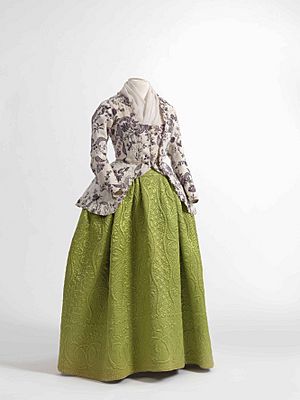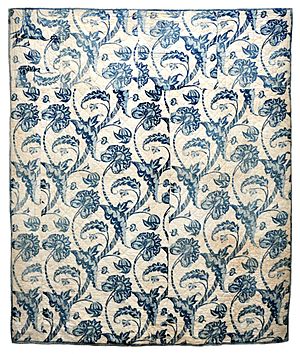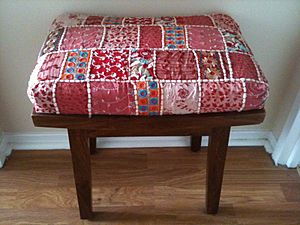Quilting facts for kids
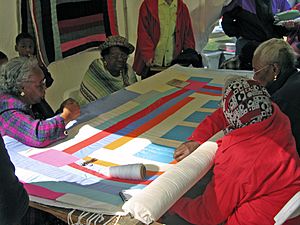
Quilting is a way of sewing two or more layers of fabric together. This creates a thicker, padded material. People usually do this to make a quilt or a special kind of clothing.
A typical quilt has three layers. There's a top fabric, a soft middle layer called batting (like insulation), and a backing fabric. But quilters can use many different styles!
To quilt, you use a needle and thread. You push the needle through all the fabric layers. Then, you bring it back up. This is repeated all over the area you want to quilt. Common stitches include rocking, straight, or running stitches. These stitches can be for holding the layers together or for decoration.
Quilting is used for many things. These include bed covers, wall hangings (called art quilts), clothing, and other fabric items. The patterns you choose can make different effects. For example, dense quilting can make one area flat, making another part stand out.
Making a quilt involves more than just sewing. It also includes designing, cutting fabric, piecing (sewing small pieces together), appliqué (sewing shapes onto a background), and binding (finishing the edges). A person who quilts is called a quilter. Quilting can be done by hand, with a sewing machine, or with a special longarm quilting system.
Quilt stores often sell fabric, thread, and patterns. They also offer other supplies for quilting. Many stores have classes where you can learn to sew or quilt.
Contents
History of Quilting
How Quilting Started
No one knows exactly when quilting began. But sewing techniques like piecing, appliqué, and quilting have been used for thousands of years. People used them for clothes and home items all over the world.
The oldest known quilted clothing is shown on an ivory figure. It's of an ancient Pharaoh from ancient Egypt. This figure is from around 3400 BC. In 1924, archaeologists found a quilted floor covering in Mongolia. Experts think it's from between 100 BC and 200 AD.
In Europe, quilting has been around since about the fifth century. Early quilted items had Egyptian cotton. This might mean that trade with Egypt and the Mediterranean helped spread the technique. However, quilted items were rare in Europe until about the twelfth century. That's when quilted bedding appeared after Crusaders returned from the Middle East.
Medieval quilted garments were worn under or instead of armor. These later became the quilted doublet. This was a fashionable part of European men's clothing from the 1300s to the 1600s. The oldest surviving European bed quilt is from Sicily. It's called the Tristan Quilt and is from the late 1300s. It's made of linen and padded with wool. The quilt shows scenes from the legend of Tristan. It's now in the Victoria and Albert Museum in London.
The word quilt comes from the Latin word culcita. This means "a stuffed sack." It came into the English language from the French word cuilte.
American Quilts
In early American Colonial times, most quilts were "whole-cloth" quilts. These used one large piece of fabric for the top. This was layered with batting and backing. Fine needlework held them together. Broderie perse quilts were also popular. These used cut-out fabric designs sewn onto a background. Most quilts from 1770-1800 were "medallion-style." They had a main design in the center with borders around it.
Patchwork quilting in America started around the 1770s. This was when the United States became independent. These old patchwork quilts often mixed different fabrics. They used wool, silk, linen, and cotton in the same quilt. They also mixed large patterns with small ones. Some old quilts in North America even used worn-out blankets or older quilts as the middle batting layer. This helped reuse old materials.
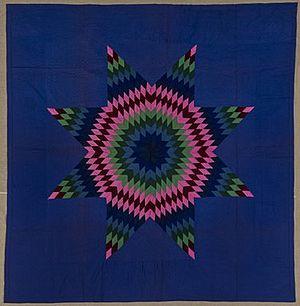
During American pioneer days, "foundation piecing" became popular. Paper was cut into shapes and used as a pattern. Each fabric piece was sewn around the paper pattern. Paper was hard to find in the early American West. So, women saved letters, postcards, and newspapers to use as patterns. The paper not only helped with the pattern but also added warmth. The paper found inside old quilts now gives us information about pioneer life.
Quilts made without any batting were called summer quilts. They were not for warmth. They just helped keep the chill off on cool summer evenings.
African-American Quilts
African-American quilting has a long history. It began with quilts made by enslaved people for themselves and their owners. The style of these quilts depended on the time and place. After 1865, when slavery ended, African Americans started their own unique quilting style.
Harriet Powers, an African American woman born into slavery, made two famous story quilts. She was one of many African-American quilters who helped quilting grow. African-American quilt-making first became widely known in 2002. This was when an exhibition of quilts from the Gee's Bend community opened. It traveled to many museums, including the Smithsonian.
Gee's Bend is a small, remote community in Alabama. It has a quilting tradition that goes back many generations. Their quilts are known for creative patterns, bright colors, and a lively look. The US Postal Service has even honored the contributions of Harriet Powers and the quilters of Gee's Bend, Alabama with a series of stamps. These stamps also honored how quilting can bring people together.
A legend grew from a children's story, Sweet Clara and the Freedom Quilt (1989). It said that enslaved people used quilts to send secret messages to escape on the Underground Railroad. However, historians agree there is no real proof for this belief. There are no mentions of it in the thousands of slave narratives or other records from that time.
Amish Quilts
Another American group with a special quilting style is the Amish. Their quilts usually use only solid fabrics. They are made from geometric shapes and do not have appliqué. The way they are made is simple and done entirely by hand.
Amish quilters often use simple patterns. For example, Amish from Lancaster County are known for their Diamond-in-a-Square and Bars patterns. Other communities use patterns like Brick, Streak of Lightning, and Log Cabins. Midwestern communities are known for repeating block patterns. Borders and color choices also change by community. Lancaster quilts have wide borders with fancy quilting. Midwestern quilts have narrower borders to balance the more detailed piecing.
Native American Quilts
Some Native Americans learned quilting by watching white settlers. Others learned from missionaries who taught quilting to Native American women. Native American women quickly created their own unique style. This was the Lone Star design (also called the Star of Bethlehem). It was a new version of Morning Star designs already seen on Native American clothing for centuries. These quilts often had floral appliqué around the star design. Quilts showing pictures, made with appliqué, were also common.
Another special Native American quilting style is Seminole piecing. It was created by Seminoles living in the Florida Everglades. This style developed because they needed fabric. The closest town was often a week's journey away. Women would sew strips of leftover fabric together. Then they would sew these into larger pieces to make clothing. Eventually, this style was used for quilts too. In 1900, sewing machines and fabric became easier to get. The patterns became much more detailed. This style is still used today by Seminole women and others who have learned their designs.
Hawaiian Quilting
Hawaiian quilting was well known by the early 1900s. Hawaiian women learned to quilt from the wives of missionaries from New England in the 1820s. They learned both pieced work and appliqué. By the 1870s, they had changed appliqué techniques to create a unique Hawaiian style. The classic Hawaiian quilt design is large and bold. It has a curved appliqué pattern that covers most of the quilt. The symmetrical design is cut from just one piece of fabric.
South Asian Quilting
There are two main types of quilting from South Asia: Nakshi Kantha and Ralli. Nakshi Kantha quilts started in India. They are usually made from fabric scraps and worn-out cloth. These are stitched together with old sari threads using kantha embroidery stitches. The fabric layers were spread on the ground, held down, and sewn together with large stitches. The oldest recorded kantha quilts are over 500 years old.
Ralli quilts are traditionally made in Pakistan, western India, and nearby areas. They are made by women from all parts of society. This includes Hindu and Muslim women, and women from different towns or tribes. The colors and designs vary among these groups. The name Ralli comes from ralanna, meaning "to mix or connect." One woman designs and pieces the quilt tops using scraps of hand-dyed cotton. This cotton often comes from old dresses or shawls. Once the top is pieced, it's placed on a mat with other layers. Then, family and community members sew it together using thick, colored thread in straight lines.
Swedish Quilting
Quilting began in Sweden in the 1400s. Heavily stitched and appliquéd quilts were made for very wealthy people. These quilts were made from silk, wool, and felt. They were meant to be both decorative and useful. They were found in churches and in the homes of noble families.
Imported cotton first arrived in Sweden in 1870. It soon appeared in Swedish quilts, along with scraps of wool, silk, and linen. As cotton became more available and cheaper, quilting became popular among all classes in Sweden. Wealthier quilters used wool batting. Others used linen scraps, rags, or paper mixed with animal hair. These quilts were generally simple and narrow. Both men and women made them. The biggest influence on Swedish quilting at this time came from America. Swedish immigrants returned home when conditions improved in Sweden, bringing new ideas.
Art Quilting
In the late 1900s, art quilts became popular. These quilts are valued for their beauty and artistic qualities. They are displayed on a wall or table, not used on a bed. It's believed that decorative quilting came to Europe and Asia during the Crusades (1100-1300 AD). This makes sense because textile arts were more developed in China and India than in the West.
Modern Quilting
In the early 2000s, modern quilting became a bigger part of the quilting world. Modern quilting has a unique look. It gets ideas from modern architecture, art, and design. It uses traditional quilt-making techniques. Modern quilts are different from art quilts because they are made to be used. Modern quilts are also influenced by the Quilters of Gee's Bend, Amish quilts, and famous quilters like Nancy Crow and Denyse Schmidt.
The Modern Quilt Guild has tried to define modern quilting. Modern quilts often use bold colors and prints. They have strong contrast and large areas of solid color. They might use creative, unplanned piecing, simple designs, lots of empty space, and different grid patterns.
The Modern Quilt Guild is a non-profit group. It has 14,000 members in over 200 local groups across 39 countries. It supports modern quilting through local guilds, online classes, and QuiltCon. QuiltCon is an annual modern quilting conference. The first Modern Quilt Guild started in October 2009 in Los Angeles.
QuiltCon includes a quilt show with over 400 quilts. It also has vendors, talks, and quilting workshops. The first QuiltCon was in Austin, Texas, from February 21–24, 2013. QuiltCon 2020 was also held in Austin, Texas, from February 20–23, 2020. It showed 400 modern quilts from quilters around the world.
Quilting in Fashion and Design
Unique quilting designs have become popular for decorating fabrics. As industrial sewing machines became more advanced, quilting with unusual fabrics and embroidery started appearing in home furnishings in the early 2000s.
Quilt Blocks
A quilt block is a smaller part made of several fabric pieces sewn together. Quilt blocks are repeated, or sometimes mixed with plain blocks. This creates the overall design of a quilt. Barbara Brackman has documented over 4000 different quilt block patterns. These patterns are from the early 1830s to the 1970s. Some simpler quilt block designs include the Nine-Patch, Shoo Fly, Churn Dash, and Prairie Queen.
A Nine Patch is made by sewing five patterned or dark pieces to four light square pieces. These nine sewn squares make one block.
The Shoo Fly block is a bit different from the Nine Patch. It divides each of the four corner pieces into a light and dark triangle.
Another variation happens when one square piece is divided into two equal rectangles in the basic Nine Patch design. The Churn Dash block combines triangles and rectangles to expand the Nine Patch.
The Prairie Queen block uses two large triangles in the corner section. The middle section uses four squares. The center piece is one full-size square. Each of the nine sections has the same overall size and fits together.
Images for kids
-
Child's futon sleeping mat (boro shikimono), late 1800s Japan. The stitches are decorative, but also functional; they hold the pieced cotton rags together



